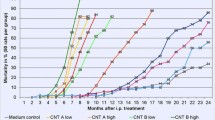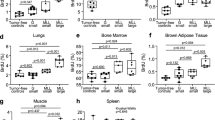Summary
N-Propyl-N-nitrosourea is a strong leukemogen that induces myelogenic leukemia in Donryu rats and thymic lymphoma in F344 rats when administered in drinking water. In the present study, a single or multiple doses of PNU (total 500 mg/kg body weight) was given to young male and female F344 rats via a stomach tube. The results demonstrated that the percentage of tumor-bearing rats was 100% in all PNU-treated male groups, while that of the control group was 46%. Predominant tumors induced by PNU in male rats were lung adenoma/adenocarcinoma followed by peritoneal mesothelioma, and forestomach papilloma. In females, the tumor incidence of PNU-treated groups varied between 58% and 92% while that of the control group was 42%. Although pituitary tumor was the most frequent tumor in PNU-treated female rats, it was thought to be spontaneous since its incidence in each experimental group was not statistically different from that of the control group. Lung tumors and forestomach papillomas were also induced by PNU in female rats. No thymic lymphoma, however, was found in any of the PNU-treated groups of either sex. Lung tumors developed in almost all PNU-treated male rats and in about one-third of PNU-treated female rats. Mesothelioma was induced only in male rats, and its incidence depended on the treatment schedule. Induced mesotheliomas were extensively examined histologically, histochemically, immunohistochemically, and electron microscopically.
Similar content being viewed by others
Abbreviations
- PNU:
-
N-propyl-N-nitrosourea
- DMSO:
-
dimethyl sulfoxide
- PAP:
-
peroxidase-anti-peroxidase
References
Anderson KA, Hurley WC, Hurley BT, Ohrt DW (1985) Malignant pleural mesothelioma following radiotherapy in a 16-year-old boy. Cancer 56:273–276
Berman JJ, Rice JM (1979) Mesotheliomas and proliferative lesions of the testicular mesothelium produced in Fischer, Sprague-Dawley and Buffalo rats by methyl(acetoxymethyl)nitrosamine (DMN-OAc). Vet Pathol 16:574–582
Cabral JRP, Neal GE (1983) Testicular mesotheliomas in rats exposed to N-2-fluorenylacetamide (FAA). Tumori 69:195–199
Dardick I, Al-Jabi M, McCaughey E, Srigley JR, Van Nostrand AWP, Ritchie AC (1984) Ultrastructure of poorly differentiated diffuse epithelial mesotheliomas. Ultrastruct Pathol 7:151–160
Gould DH (1977) Mesotheliomas of the tunica vaginalis propuria and peritoneum in Fischer rats. Vet Pathol 14:372–379
International Agency for Research on Cancer (1977) Carcinogenicity and related studies in animals. In: IARC monographs on the evaluation of carcinogenic risk of chemicals to man, vol 14, asbestos. International Agency for Research on Cancer, Lyon, pp 42–58
Jasani B, Edwards RE, Thomas ND, Gibbs AR (1985) The use of vimentin antibodies in the diagnosis of malignant mesothelioma. Virchows Arch A 406:441–448
Kawai T, Suzuki M, Shinmei M, Maenaka Y, Kageyama K (1985) Glycosaminoglycans in malignant diffuse mesothelioma. Cancer 56:567–574
Konishi Y, Denda A, Kondo H, Takahashi S (1976) Lung carcinomas induced by oral administration of N-bis(2-hydroxypropyl)nitrosamine in rats. Gann 67:773–780
Kurokawa Y, Hayashi Y, Maekawa A, Takahashi M, Kokubo T, Odashima S (1983) Carcinogenicity of potassium bromate administered orally to F344 rats. J Natl Cancer Inst 71:965–972
Lijinski W, reuber M, Singer GM (1983) Induction of tumors of the esophagus in rats by nitrosomethylalkylamines. J Cancer Res Clin Oncol 106:171–175
Maekawa A, Ogiu T, Onodera H, Furuta K, Matsuoka C, Mochizuki M, Anjo T, Okada M, Odashima S (1982) Carcinogenicity of N-alkyl-(acetoxymethyl)-nitrosamine, after subcutaneous injections in F344 rats. J Cancer Res Clin Oncol 104:13–21
Maekawa A, Kurokawa Y, Takahashi M, Kokubo T, Ogiu T, Onodera H, Tanigawa H, Ohno Y, Furukawa F, Havashi Y (1983) Spontaneous tumors in F-344/DuCrj rats. Gann 74:365–372
Maekawa A, Ogiu T, Matsuoka C, Onodera H, Furuta K, Kurokawa Y, takahashi M, Kokubo T, Tanigawa H, Hayashi Y, Nakadate M, Tanimura A (1984) Carcinogenicity of low doses of N-ethyl-N-nitrosourea in F344 rats: a dose-response study. Gann 75:117–125
Mohr U, Reznik G, Pour P (1976) Carcinogenic effects of diisopropanolnitrosamine in Sprague-Dawley rats. J Natl Cancer Inst 58:361–366
Nakakuki K, Itoh H (1985) Pathologic analysis and classification of rat thymic lymphoma correlated with its biological behavior. Mie Med J 35:67–79
Ogiu T, Nakadate M, Odashima S (1975) Induction of leukemias and digestive tract tumors in Donryu rats by 1-propyl-1-nitrosourea. J Natl Cancer Inst 54:887–893
Ogiu T, Nakadate M, Odashima S (1976) Induction of tumors in female Donryu rats by a single administration of 1-propyl-1-nitrosourea. Gann 67:121–124
Pour P, Salmasi S, Runge R, Gingell R, Wallcave L, Nagel D, Stepan K (1979) Carcinogenicity of N-nitrosobis(2-hydroxypropyl)amine and N-nitrosobis-(2-oxopropyl)amine in MRC rats. J Natl Cancer Inst 63:181–190
Schmähl D, Habs H (1980) Carcinogenicity of N-nitroso compounds. Species and route differences in regard to organotropism. Oncology 37:237–242
Shisa H, Hiai H (1985) Genetically determined susceptibility of Fischer 344 rats to propylnitrosourea-induced thymic lymphomas. Cancer Res 45:1483–1487
Takeuchi M, Ogiu T, Nakadate M, Odashima S (1980) Induction of duodenal tumors and thymomas in Fischer rats by continuous oral administration of 1-propyl-1-nitrosourea. Gann 71:231–237
Tanigawa H, Onodera H, Maekawa A (1987) Spontaneous mesotheliomas in Fischer rats—a histological and electron microscopic study. Toxicol Pathol 15:157–163
Terao K (1978) Mesotheliomas induced by sterigmatocystain in Wistar rats. Gann 69:237–247
Wagner JC, Skidmore JW, Hill RJ, Griffiths DM (1985) Erionite exposure and mesotheliomas in rats. Br J Cancer 51:727–730
Wang NS (1973) Electron microscopy in the diagnosis of pleural mesotheliomas. Cancer 31:1046–1054
Whitaker D, Shilkin KB (1984) Diagnosis of pleural malignant mesothelioma in life—a practical approach. J Pathol 143:147–175
Author information
Authors and Affiliations
Rights and permissions
About this article
Cite this article
Ogiu, T., Fukami, H. & Maekawa, A. Induction of lung tumors and peritoneal mesotheliomas in F344 rats given intragastric N-propyl-N-nitrosourea and histochemical, immunohistochemical, and ultrastructural characteristics of induced mesotheliomas. J Cancer Res Clin Oncol 114, 259–265 (1988). https://doi.org/10.1007/BF00405831
Received:
Accepted:
Issue Date:
DOI: https://doi.org/10.1007/BF00405831




